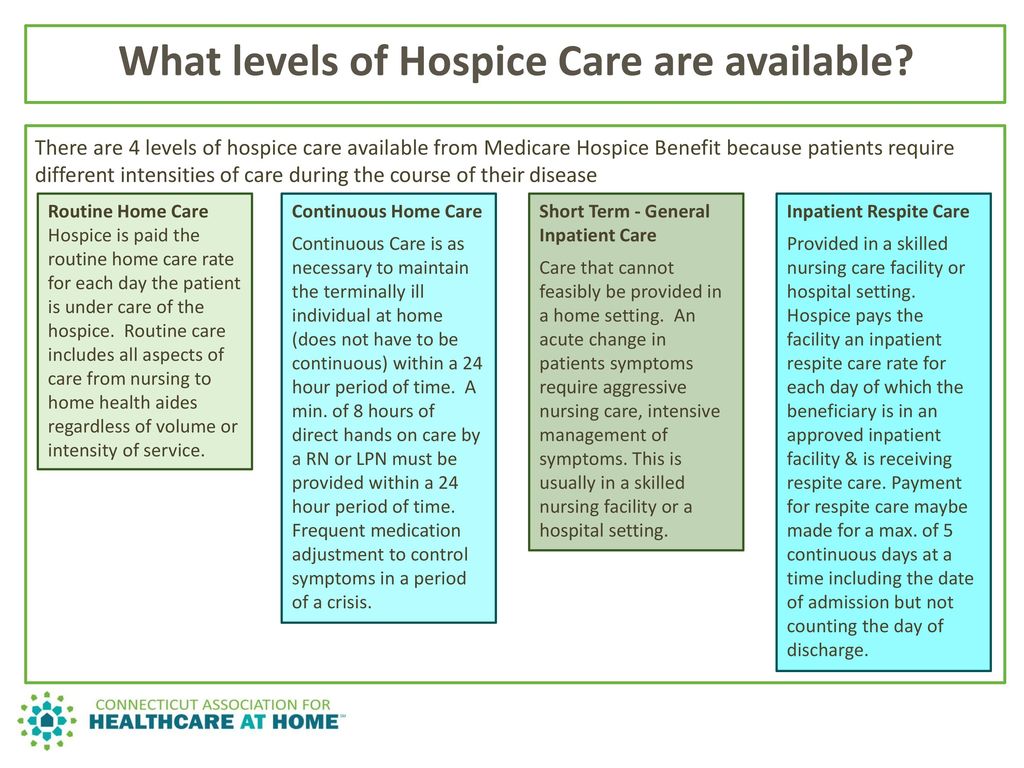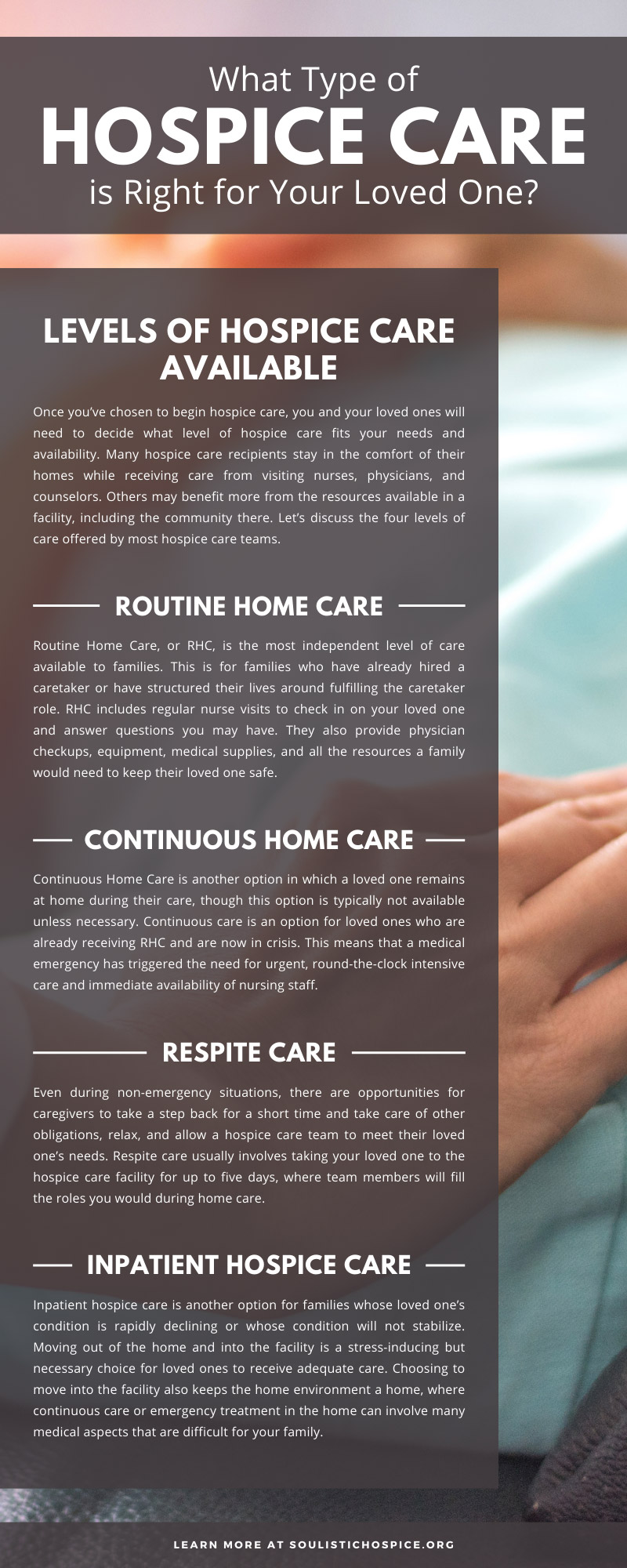What are the four levels of hospice care?

May 08, 2023
As we age, our health and wellbeing become even more important in maintaining a high quality of life, especially in our later years. Hospice care is an incredibly important resource for those who are facing terminal illness or end-of-life issues. But many people are unaware that hospice care actually occurs on four different levels. Understanding these levels can help patients and their families identify and receive the appropriate care they need during this difficult time. In this blog post, we’ll explore the four levels of hospice care, and discuss what each level entails. Whether you’re a patient, a caregiver, or simply someone interested in learning more about end-of-life care, this blog post is an essential read.

1. Introduction to Hospice Care
As someone who has experienced the difficulty of caring for a loved one with a terminal illness, I understand the importance of hospice care. Hospice is a multilevel care system that focuses on managing symptoms and improving quality of life. Its main goal is to provide comfort and support to someone with a terminal illness. Hospice care is also known as end-of-life care or comfort care.
Hospice care involves a holistic approach, considering the physical, emotional, and spiritual needs of the patient and their family. The Centers for Disease Control and Prevention (CDC) estimate that in 2018 alone, 1.6 million people received hospice care. Medicare defines four levels of hospice care, including routine, continuous, inpatient, and respite care. Each level of care caters to the different needs of the patient, and the hospice team will guide physicians and family members in choosing the best care option. Hospice is covered by Medicare, Medicaid, and some private insurances. There are also self-payment and charity care options available. [1][2]
2. Holistic Approach of Hospice Care
As someone who has seen many loved ones go through end-of-life care, I can attest to the value of hospice care. Hospice care is a holistic approach to caring for patients at the end of life, treating the whole person by addressing their medical, emotional, social, and spiritual needs. Hospice care focuses on enhancing the quality of life of the patient and their family by providing comfort and support. Care is tailored to each patient’s individual needs and circumstances. It includes skilled nursing, medication management, emotional support, and other services. All services follow an individualized plan of care tailored to the specific needs of each patient and their family. In all circumstances, hospice care focuses on pain control and symptom management while addressing the patient’s full medical, emotional, social, and spiritual needs. [3][4]
3. Medicare-defined Four Levels of Hospice Care
As someone who works in hospice care, I often get asked about the different levels of care. Here’s what you need to know about the four levels of hospice care as defined by Medicare:
1. Routine Hospice Care: This is the most common level of hospice care and focuses on managing symptoms and improving quality of life for patients. It can be provided in any setting, such as the patient’s home or a nursing facility.
2. Continuous Hospice Care: This level of care is for patients who require round-the-clock nursing support, typically during a medical crisis or when symptoms become unmanageable.
3. Inpatient Hospice Care: Sometimes referred to as ‘general inpatient care’, this level of care is provided in a hospital or similar facility and is intended to manage severe pain or other symptoms that cannot be controlled at home.
4. Respite Care: This type of care can provide caregivers with a break from caregiving responsibilities and is typically offered on a short-term basis in an inpatient facility.
Remember, the goal of hospice care is to provide expert medical care and emotional support for patients and their families during a difficult time. [5][6]

4. Routine Hospice Care
As a hospice nurse, I often see patients and families who are unsure what to expect from hospice care. Routine hospice care is the most common level of hospice care. It focuses on increasing a patient’s comfort and quality of life in their own home. This kind of hospice care is intermittent and dependent on a patient’s needs. Routine care includes services for pain and symptom management, assistance with daily tasks, emotional and spiritual counseling for both the patient and their families, nutritional services, and therapeutic services.
It’s important to note that hospice care is usually covered through the Medical Hospice Benefit or other health insurance plans. Medicare defines the four distinct levels of hospice care, so it’s crucial to work closely with physicians and hospice teams when determining the appropriate level of care for you or your loved one. Understanding hospice care can provide peace of mind and the best outcomes for patients facing life-limiting illnesses or health conditions. [7][8]

5. Continuous Hospice Care
As someone who has cared for loved ones receiving hospice care, I know firsthand the benefits of continuous hospice care. This level of care is necessary when a person experiences a medical crisis or when their symptoms require more intensive management.
Continuous hospice care provides round-the-clock nursing or extended periods of nursing support during this kind of medical crisis. This level of care benefits both the patient and their family, allowing caregivers the opportunity to step back from hands-on care and focus on being with their loved one in a family role.
Patients may receive continuous hospice care in their home or in an inpatient facility. Typically, this level of care is available only during short periods of crisis and only as necessary to keep the person at home. Hospice care professionals provide care so the terminally-ill person’s caregiver can rest.
Fortunately, most hospice care is covered through the Medical Hospice Benefit or other health insurance plans, like Medicaid or TRICARE. [9][10]
6. Inpatient Hospice Care
As I’ve learned, inpatient hospice care takes place in an inpatient facility like a hospital or nursing home. This level of care focuses on pain control and symptom management that can’t be managed adequately in a home setting. A person may require inpatient hospice care if their pain or symptoms become uncontrollable. Hospice professionals provide care in an environment designed to make the patient comfortable. It’s essential to note that hospice does not mean giving up on treatment. Rather, it emphasizes comfort, quality of life, and the individual’s dignity. Inpatient hospice care is usually needed when the patient has complex medical needs, such as intense pain management or requires constant medical supervision. Patients may also receive general inpatient hospice care when their caregivers need a break from their caregiving responsibilities. Regardless of the reason, the goal is to help the patient stay comfortable and at peace. [11][12]

7. Respite Care during Hospice
In my experience, respite care is an important part of hospice care. As a caregiver, taking care of a terminally ill loved one can be overwhelming and emotionally exhausting. That’s where respite care comes in. It’s a short-term break from caregiving that can last up to 5 days. During respite care, your loved one will receive care in an approved inpatient facility. This gives you a chance to rest, recharge, and take care of other responsibilities before returning to caregiving.
Respite care is typically covered by Medicare and Medicaid, as well as some private insurances. There may be a coinsurance payment for each day of respite care, but it won’t exceed what Medicare pays for that day. It’s important to discuss respite care with your hospice team and plan for it ahead of time. Remember, taking care of yourself is just as important as taking care of your loved one. [13][14]

8. Guiding Physicians and Hospice Teams
As a hospice team member, our goal is to guide patients and their families through the end-of-life journey. We work closely with physicians to determine the appropriate level of care based on the patient’s needs and wishes. Each patient is evaluated individually to ensure they receive the best care possible.
We are available 24/7 to support patients and their families, providing emotional and spiritual counseling, pain management, and symptom management. Our team includes skilled nurses, hospice aides, social workers, chaplains, therapists, and volunteers.
We also collaborate with caregivers and monitor the patient’s condition and pain/symptom management. If necessary, we will recommend a change in the level of care. Our goal is to ensure that patients receive the care they need, while respecting their unique wishes and preferences. [15][16]

9. Eligibility for Hospice Care and Payment Options
As someone who may need hospice care in the future or may have a loved one in need, it’s important to know if you or they are eligible for this type of care and how to pay for it. Here are some key things to know:
1. To be eligible for hospice care, a doctor must certify that the patient has a terminal illness with a prognosis of 6 months or less if the illness runs its normal course.
2. Medicare Part A covers hospice care for eligible patients. This includes nursing care, medical equipment, medication for pain and symptom management, and more.
3. Medicaid also offers hospice coverage, as do some private health insurance policies.
4. Patients can also pay out-of-pocket or seek charity care for hospice services.
5. There are four levels of hospice care: routine home care, continuous home care, general inpatient care, and respite care.
6. The level of care needed will depend on the patient’s symptoms and needs at the time.
7. Hospice care provides comfort and support for both the patient and their family during a difficult time.
8. If you or a loved one are eligible for hospice care, it’s important to discuss your options with a healthcare provider and explore payment options to ensure the best possible care. [17][18]
10. Medicare Benefits and Additional Payment Options
As someone who is looking into hospice care for a loved one, I wanted to dive into the specifics of Medicare benefits and payments. Here are some things I learned:
1. If you have Medicare Part A and B, hospice care is fully covered with no out-of-pocket costs.
2. Hospice care offers four levels of care: Routine Home Care, Continuous Home Care, General Inpatient Care, and Respite Care.
3. Each level of care is tailored to specific needs and can be chosen based on a person’s symptoms and crisis level.
4. Medicaid and private insurance may also cover hospice care costs.
Understanding payment options and benefits for hospice care can alleviate some financial stress and allow families to focus on providing comfort and support for their loved one. [19][20]
Filed under:
Articles and Resource Topics

A Registered Nurse is available to answer your questions about hospice and palliative care services:
- Discuss your unique situation to determine how Inspire services can be tailored to care for you and your family
- Discuss insurance, Medicare and answer other concerns about eligibility, benefits, and other care options
- Answer any questions you have about comfort care



